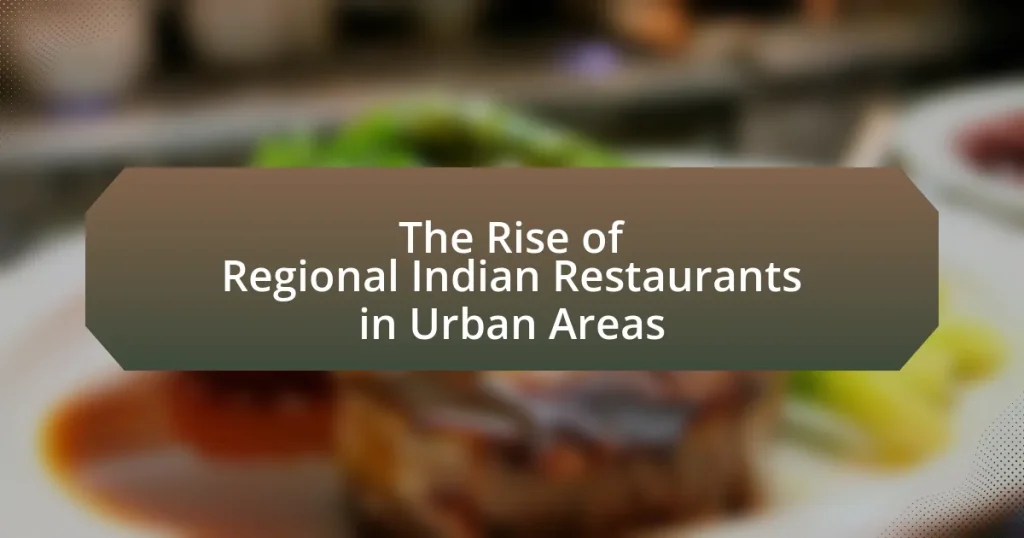The article examines the rise of regional Indian restaurants in urban areas, highlighting factors such as increasing consumer interest in diverse culinary experiences, urbanization, and demographic changes. It discusses how cultural exchanges and social media have enhanced the acceptance of regional cuisines, while also addressing the economic factors supporting this growth, including rising disposable incomes and the demand for authenticity. Additionally, the article explores the challenges these restaurants face, such as competition and sourcing authentic ingredients, and outlines strategies for success, including menu innovation, community engagement, and effective marketing practices.

What factors contribute to the rise of regional Indian restaurants in urban areas?
The rise of regional Indian restaurants in urban areas is primarily driven by increasing consumer interest in diverse culinary experiences. Urban populations are becoming more adventurous in their dining choices, seeking authentic and regional flavors that reflect India’s rich culinary heritage. This trend is supported by the growing Indian diaspora, which brings traditional recipes and cooking techniques to urban centers, enhancing the demand for regional cuisines. Additionally, the rise of social media and food blogging has amplified awareness and appreciation for regional Indian dishes, encouraging restaurants to showcase their unique offerings. According to a report by the National Restaurant Association of India, the Indian food service industry is projected to grow significantly, with regional cuisines playing a crucial role in this expansion.
How has urbanization influenced the popularity of regional Indian cuisine?
Urbanization has significantly increased the popularity of regional Indian cuisine by creating diverse urban populations that seek authentic culinary experiences. As cities expand, they attract people from various regions, leading to a demand for traditional dishes that reflect their cultural heritage. This demand has resulted in the establishment of numerous regional Indian restaurants in urban areas, showcasing specific cuisines such as Punjabi, Bengali, and South Indian. According to a report by the National Restaurant Association of India, the restaurant industry has seen a growth rate of 10-12% annually, driven largely by urban consumers’ interest in regional flavors. This trend highlights how urbanization not only facilitates the availability of regional cuisines but also fosters a culinary landscape that celebrates India’s rich gastronomic diversity.
What demographic changes are driving the demand for regional Indian restaurants?
The demand for regional Indian restaurants is primarily driven by the increasing diversity of urban populations. As cities become more multicultural, the presence of various ethnic communities, including a significant number of Indian immigrants, has led to a greater appreciation for authentic regional cuisines. According to the 2020 U.S. Census, the Asian population, particularly those of Indian descent, has grown by 81% since 2000, contributing to a heightened interest in regional Indian dishes that reflect the culinary traditions of different states in India. This demographic shift not only increases the customer base for these restaurants but also encourages culinary innovation and the introduction of lesser-known regional dishes to a broader audience.
How do cultural exchanges in urban areas impact the acceptance of regional cuisines?
Cultural exchanges in urban areas significantly enhance the acceptance of regional cuisines by fostering diversity and encouraging culinary experimentation. Urban environments, characterized by their multicultural populations, create opportunities for individuals to experience and appreciate various food traditions. For instance, the presence of diverse communities in cities like New York and London has led to the proliferation of Indian restaurants that showcase regional specialties, such as South Indian dosa or North Indian biryani, which may not have been widely recognized outside their local contexts. Research indicates that exposure to different cuisines through cultural festivals and food markets increases consumer interest and willingness to try new dishes, thereby promoting the acceptance of regional cuisines.
Why are consumers increasingly seeking authentic regional Indian dining experiences?
Consumers are increasingly seeking authentic regional Indian dining experiences due to a growing desire for cultural authenticity and unique culinary diversity. This trend is driven by a heightened interest in exploring traditional flavors and cooking methods that reflect the rich heritage of various Indian regions. According to a 2022 survey by the National Restaurant Association of India, 68% of diners expressed a preference for regional cuisines over generic offerings, highlighting a shift towards valuing authenticity in dining choices. Additionally, the rise of social media has amplified exposure to diverse food experiences, encouraging consumers to seek out genuine regional dishes that resonate with their cultural curiosity.
What role does food authenticity play in consumer preferences?
Food authenticity significantly influences consumer preferences by enhancing trust and satisfaction in dining experiences. Consumers increasingly seek genuine culinary experiences that reflect traditional recipes and local ingredients, which fosters a deeper connection to the cuisine. Research indicates that 86% of consumers are willing to pay more for authentic food experiences, as they perceive them to be of higher quality and more culturally significant. This trend is particularly evident in urban areas where regional Indian restaurants thrive by offering authentic dishes that resonate with both local and diaspora communities, reinforcing the importance of authenticity in shaping consumer choices.
How do regional Indian restaurants differentiate themselves from mainstream Indian eateries?
Regional Indian restaurants differentiate themselves from mainstream Indian eateries by offering authentic, localized dishes that reflect specific regional cuisines, often using traditional cooking methods and ingredients unique to their area. For example, a restaurant specializing in Punjabi cuisine will serve dishes like butter chicken and sarson da saag, while a South Indian restaurant will focus on dosas and idlis, showcasing the diversity of Indian culinary traditions. This focus on regional authenticity not only attracts customers seeking genuine flavors but also preserves cultural heritage, as evidenced by the increasing popularity of regional dishes in urban areas, where consumers are more adventurous and interested in exploring diverse food experiences.
What economic factors are supporting the growth of regional Indian restaurants?
The growth of regional Indian restaurants is primarily supported by increasing disposable incomes among urban consumers. As urban populations experience rising income levels, they are more willing to spend on diverse dining experiences, including regional cuisines. Additionally, the trend towards globalization has led to a greater appreciation for authentic and diverse food options, driving demand for regional Indian dishes. According to a report by the National Restaurant Association of India, the Indian food service industry is projected to grow at a CAGR of 10% from 2021 to 2025, indicating a robust market for regional cuisines. Furthermore, the expansion of delivery services and food apps has made it easier for consumers to access these restaurants, further fueling their growth.
How does the cost of ingredients affect the pricing strategies of these restaurants?
The cost of ingredients significantly influences the pricing strategies of regional Indian restaurants in urban areas. When ingredient prices rise, restaurants often adjust their menu prices to maintain profit margins, reflecting the increased cost of sourcing authentic spices, vegetables, and meats essential for regional dishes. For instance, a study by the National Restaurant Association indicates that 70% of restaurants report adjusting prices in response to ingredient cost fluctuations, particularly in markets where fresh, regional ingredients are prioritized. This adjustment ensures that restaurants can continue to offer traditional flavors while managing operational costs effectively.
What impact do local sourcing and sustainability have on restaurant success?
Local sourcing and sustainability significantly enhance restaurant success by attracting environmentally conscious consumers and improving food quality. Restaurants that prioritize local ingredients often report increased customer loyalty, as patrons prefer fresh, seasonal offerings that support local economies. A study by the National Restaurant Association found that 70% of consumers are more likely to visit a restaurant that sources food locally. Additionally, sustainable practices can reduce operational costs through waste reduction and energy efficiency, further contributing to profitability. Thus, local sourcing and sustainability not only align with consumer preferences but also bolster financial performance in the competitive restaurant industry.

What challenges do regional Indian restaurants face in urban environments?
Regional Indian restaurants in urban environments face significant challenges, including intense competition, high operational costs, and difficulty in sourcing authentic ingredients. The competitive landscape is marked by numerous dining options, making it hard for these restaurants to attract and retain customers. High operational costs, including rent and labor, can strain their financial viability, especially in densely populated urban areas where expenses are elevated. Additionally, sourcing authentic ingredients can be problematic due to supply chain issues and limited availability, which can compromise the authenticity of the cuisine that these restaurants aim to offer.
How do competition and market saturation affect regional Indian restaurants?
Competition and market saturation significantly impact regional Indian restaurants by intensifying the struggle for customer loyalty and profitability. As more regional Indian restaurants enter urban markets, they face increased competition, which can lead to price wars and reduced profit margins. For instance, a study by the National Restaurant Association indicates that the restaurant industry is highly competitive, with over 1 million establishments in the U.S. alone, making it crucial for regional Indian restaurants to differentiate themselves through unique offerings and exceptional service. Additionally, market saturation can lead to a limited customer base, forcing restaurants to innovate or risk closure. In densely populated urban areas, the presence of numerous similar dining options can dilute brand identity and customer retention, necessitating strategic marketing and menu diversification to attract and maintain clientele.
What strategies can restaurants employ to stand out in a crowded market?
Restaurants can stand out in a crowded market by offering unique regional cuisine, exceptional customer service, and engaging marketing strategies. By focusing on authentic regional Indian dishes, restaurants can attract customers seeking diverse culinary experiences, as evidenced by the growing popularity of regional Indian restaurants in urban areas, which have seen a 20% increase in patronage over the past five years. Additionally, providing personalized service enhances customer loyalty, with studies showing that 70% of consumers are willing to pay more for better service. Finally, leveraging social media and local partnerships for marketing can effectively reach target demographics, as 80% of consumers report discovering new restaurants through social platforms.
How do consumer trends impact the menu offerings of regional Indian restaurants?
Consumer trends significantly influence the menu offerings of regional Indian restaurants by driving the demand for authenticity, health-conscious options, and innovative fusion dishes. As urban consumers increasingly seek authentic culinary experiences, regional Indian restaurants adapt their menus to feature traditional recipes and locally sourced ingredients, reflecting the diverse culinary heritage of India. Additionally, the growing trend towards health and wellness prompts these restaurants to incorporate healthier alternatives, such as vegetarian, vegan, and gluten-free options, catering to the dietary preferences of modern diners. Furthermore, the popularity of fusion cuisine encourages regional Indian restaurants to experiment with blending traditional Indian flavors with global culinary techniques, thereby attracting a broader audience. This responsiveness to consumer preferences is evidenced by the rise in popularity of dishes like quinoa biryani and avocado parathas, which combine traditional elements with contemporary health trends.
What operational challenges do these restaurants encounter?
Regional Indian restaurants in urban areas encounter several operational challenges, including sourcing authentic ingredients, managing labor shortages, and navigating regulatory compliance. Sourcing authentic ingredients can be difficult due to limited availability and higher costs, which can affect menu authenticity and pricing. Labor shortages are prevalent in the restaurant industry, leading to increased competition for skilled workers and higher wage demands. Additionally, navigating regulatory compliance, such as health and safety regulations, can be complex and time-consuming, often requiring significant administrative effort to ensure adherence. These challenges can hinder operational efficiency and profitability for these establishments.
How does staffing and training influence the quality of service in regional Indian restaurants?
Staffing and training significantly influence the quality of service in regional Indian restaurants by ensuring that employees are knowledgeable and skilled in both culinary and customer service aspects. Well-trained staff can effectively communicate menu items, provide recommendations, and address customer inquiries, which enhances the dining experience. Research indicates that restaurants with comprehensive training programs see a 20% increase in customer satisfaction ratings, as employees are better equipped to handle diverse customer needs and preferences. Additionally, adequate staffing levels prevent service delays, allowing for timely food delivery and attentive customer care, which are critical in maintaining high service quality.
What logistical issues arise in sourcing regional ingredients for urban restaurants?
Sourcing regional ingredients for urban restaurants presents several logistical issues, including transportation challenges, supply chain inconsistencies, and seasonal availability. Urban restaurants often rely on timely deliveries from rural suppliers, which can be hindered by distance and traffic congestion, leading to delays in ingredient freshness. Additionally, fluctuations in supply due to weather conditions or crop yields can disrupt the availability of specific regional ingredients, making it difficult for restaurants to maintain menu consistency. For instance, a study by the Food and Agriculture Organization indicates that transportation costs can increase by up to 30% when sourcing ingredients from remote areas, further complicating the logistics for urban establishments.

How can regional Indian restaurants thrive in urban settings?
Regional Indian restaurants can thrive in urban settings by offering authentic, diverse cuisine that caters to local tastes while maintaining cultural integrity. This approach attracts a broad customer base, including both Indian expatriates seeking familiar flavors and urban dwellers interested in exploring new culinary experiences.
Additionally, leveraging social media and food delivery platforms enhances visibility and accessibility, allowing these restaurants to reach a wider audience. According to a report by the National Restaurant Association, 60% of consumers are more likely to order from restaurants that actively engage on social media.
Furthermore, creating a unique dining experience through ambiance, cultural events, and community engagement fosters customer loyalty and repeat visits. A study published in the Journal of Foodservice Business Research indicates that restaurants that host cultural events see a 25% increase in customer retention.
By focusing on authenticity, effective marketing, and community involvement, regional Indian restaurants can successfully navigate the competitive urban dining landscape.
What marketing strategies are effective for promoting regional Indian cuisine?
Effective marketing strategies for promoting regional Indian cuisine include leveraging social media platforms, hosting food festivals, and collaborating with local influencers. Social media platforms like Instagram and Facebook allow restaurants to showcase vibrant dishes and engage with potential customers through visually appealing content. Hosting food festivals can create immersive experiences that highlight regional specialties, attracting food enthusiasts and increasing brand visibility. Collaborating with local influencers can enhance credibility and reach, as these individuals often have established trust with their followers, making them effective advocates for regional cuisine. These strategies are supported by the growing trend of experiential dining, where consumers seek authentic culinary experiences, thus validating the effectiveness of these marketing approaches.
How can social media be leveraged to attract a diverse customer base?
Social media can be leveraged to attract a diverse customer base by utilizing targeted advertising and engaging content that reflects various cultural backgrounds. For instance, regional Indian restaurants can create tailored ads that highlight specific cuisines, festivals, or community events relevant to different demographic groups. Research indicates that 70% of consumers feel more connected to brands that share content relevant to their cultural identity, demonstrating the effectiveness of culturally resonant marketing. Additionally, user-generated content, such as customer reviews and photos, can enhance authenticity and appeal to a broader audience, as 79% of consumers trust online reviews as much as personal recommendations. By actively engaging with diverse communities on platforms like Instagram and Facebook, restaurants can foster inclusivity and attract a wider range of customers.
What role do community engagement and events play in building a loyal customer base?
Community engagement and events are crucial in building a loyal customer base for regional Indian restaurants in urban areas. These activities foster a sense of belonging and connection among customers, encouraging repeat visits. For instance, hosting cultural events or cooking classes allows restaurants to showcase their unique offerings while creating memorable experiences that resonate with the community. Research indicates that businesses that actively engage with their local communities see a 20% increase in customer loyalty, as customers feel more invested in brands that reflect their values and culture. By creating a vibrant community atmosphere, regional Indian restaurants can effectively cultivate a dedicated customer base.
What best practices can regional Indian restaurants adopt for long-term success?
Regional Indian restaurants can adopt several best practices for long-term success, including focusing on authentic regional cuisine, maintaining high-quality ingredients, and creating a strong brand identity. Authentic regional cuisine attracts customers seeking genuine culinary experiences, as evidenced by the growing trend of diners favoring unique, local flavors over generic offerings. High-quality ingredients not only enhance the taste but also build customer trust and loyalty; studies show that restaurants using fresh, locally sourced produce often see increased patronage. Additionally, a strong brand identity, which can be developed through effective marketing and community engagement, helps differentiate a restaurant in a competitive urban market, leading to sustained customer interest and repeat business.
How can menu innovation enhance customer experience and retention?
Menu innovation can enhance customer experience and retention by offering unique, culturally relevant dishes that cater to evolving consumer preferences. This approach not only attracts new customers seeking authentic regional flavors but also encourages repeat visits from existing patrons who appreciate the variety and creativity in the menu. Research indicates that 70% of consumers are more likely to return to a restaurant that frequently updates its menu with innovative options, as it keeps the dining experience fresh and exciting. Additionally, incorporating seasonal ingredients and local specialties can create a stronger connection with the community, further enhancing customer loyalty.
What are the benefits of collaborating with local food producers and suppliers?
Collaborating with local food producers and suppliers enhances the quality and freshness of ingredients used in regional Indian restaurants. This partnership allows restaurants to source seasonal and locally grown produce, which not only improves flavor but also supports sustainable farming practices. According to a study by the USDA, local sourcing can reduce carbon footprints by minimizing transportation distances, thereby contributing to environmental sustainability. Additionally, working with local suppliers fosters community relationships and can lead to unique menu offerings that reflect regional culinary traditions, attracting customers interested in authentic dining experiences.
What tips can aspiring restaurateurs consider when opening a regional Indian restaurant?
Aspiring restaurateurs should focus on authentic regional cuisine, sourcing ingredients directly from local suppliers to ensure freshness and quality. Understanding the specific regional flavors and cooking techniques is crucial, as this knowledge will help in creating a menu that resonates with customers seeking genuine experiences. Additionally, conducting market research to identify target demographics and their preferences can guide menu development and marketing strategies.
Establishing a strong brand identity that reflects the regional heritage will attract customers and differentiate the restaurant from competitors. Engaging with the local community through events or partnerships can enhance visibility and build a loyal customer base. Finally, maintaining high standards of service and cleanliness is essential, as these factors significantly influence customer satisfaction and repeat business.
